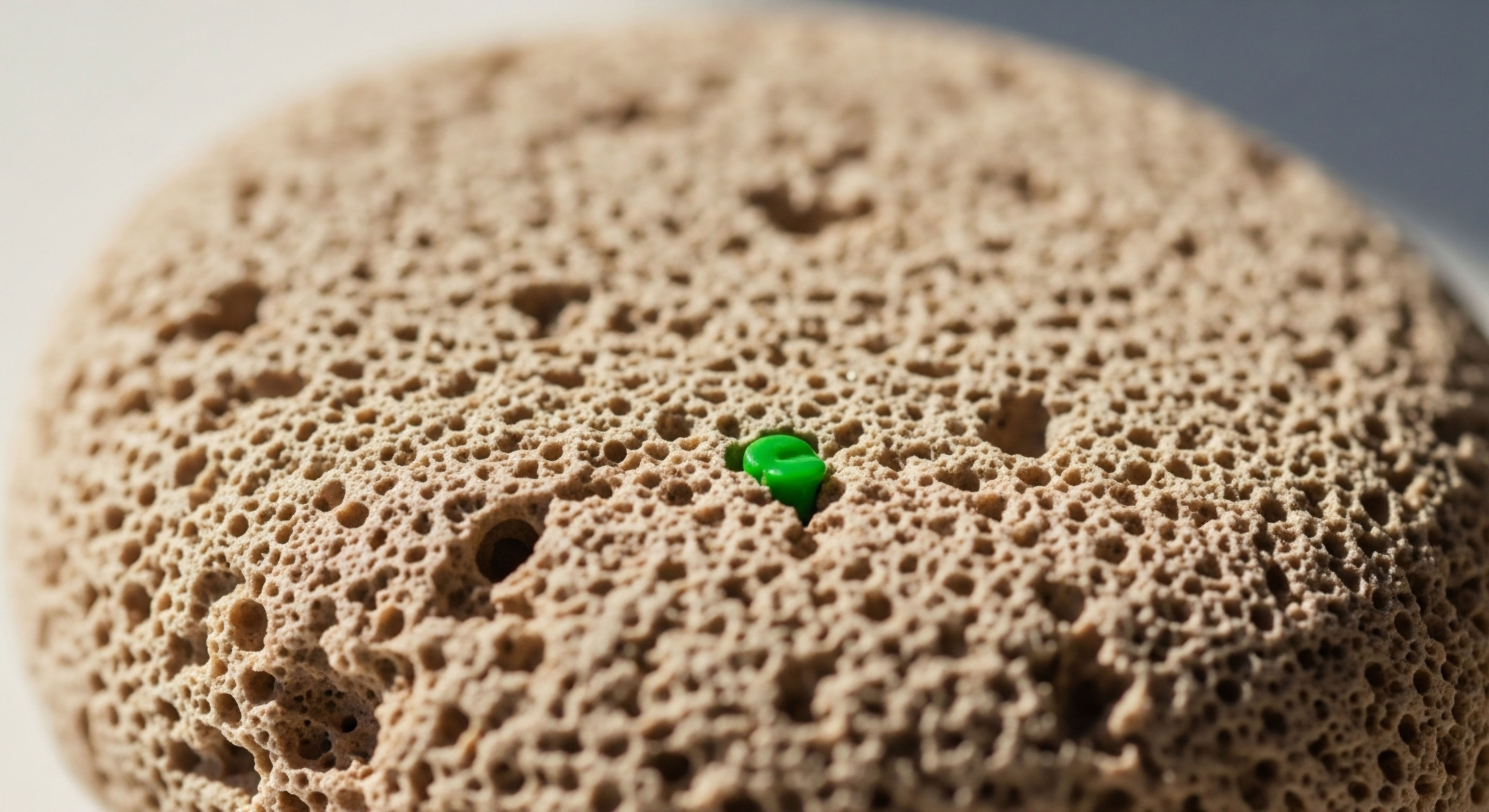

Fundamentals
The ache of an injury that lingers, the frustrating stiffness in a joint that was once fluid, or the simple observation that recovery takes longer than it used to ∞ these are deeply personal biological reports. Your body is communicating a change in its capacity for repair.
This experience is a valid and important signal. It points to a shift in the intricate, system-wide process that governs healing. The quality of your recovery from injury is a direct reflection of your body’s internal environment, a complex and interconnected network managed by your endocrine system. Understanding this system is the first step toward influencing it.
Healing is a construction project on a microscopic scale. When tissue is damaged, a carefully orchestrated sequence of events begins. Think of it as a highly specialized crew arriving at a worksite. The initial phase, inflammation, is the demolition and site-clearing crew. This process removes damaged cells and debris.
Following this, the proliferation phase begins, where new materials are brought in. Cells called fibroblasts arrive to build a scaffold of new connective tissue, primarily by producing collagen. New blood vessels are formed in a process called angiogenesis to supply the area with oxygen and nutrients. Finally, the remodeling phase is where the newly built tissue is refined, organized, and strengthened over months, or even years, to restore its original function and quality.
The body’s healing cascade is a multi-stage biological process that dictates the final quality and function of repaired tissue.

The Role of Systemic Health in Localized Repair
This entire construction project relies on clear communication and abundant resources. The communication signals are hormones and growth factors, the body’s internal messaging service. The resources are the proteins, vitamins, and cellular energy needed to perform the work. When the endocrine system is functioning optimally, these messages are clear and consistent, and resources are readily available.
A healthy baseline of hormones like testosterone and growth hormone ensures that the cellular machinery for protein synthesis and cell proliferation is primed and ready for action.
However, with age, stress, or metabolic dysfunction, this system can become less efficient. Hormonal signals may become weaker or less frequent. The availability of cellular energy might decrease. This systemic deficit is felt at the local level of the injury. The construction crew may work slower, use lower-quality materials, or receive confusing instructions.
The result is often incomplete healing, the formation of disorganized scar tissue instead of functional tissue, and a nagging sense of persistent vulnerability in the injured area. This is where the concept of therapeutic peptides becomes relevant. They are not a replacement for the body’s own healing mechanisms; they are precision tools designed to restore clarity and efficiency to the body’s innate repair communications.

Introducing Peptides as Biological Messengers
Peptides are short chains of amino acids, the building blocks of proteins. In a biological context, they function as highly specific signaling molecules. If hormones are the general memos sent out to the entire company, peptides are the direct, targeted instructions sent to a specific team for a specific task.
Peptide therapies introduce particular sequences of amino acids that mimic or modulate the body’s natural signaling processes related to repair and regeneration. They can instruct cells to increase blood vessel formation, accelerate the production of high-quality collagen, or reduce the inflammatory signals that lead to excessive scarring. By addressing specific bottlenecks in the healing cascade, these therapies aim to guide the body’s own repair crew to build stronger, more resilient, and more functional tissue over the long term.


Intermediate
To appreciate how peptide therapies influence long-term tissue integrity, we must examine the specific mechanisms of the key molecules involved. Each peptide possesses a distinct biological role, acting on different stages of the healing cascade. Their application is a clinical strategy to provide targeted signals that can amplify and direct the body’s inherent regenerative capabilities.
The effectiveness of these signals is often predicated on the body’s overall hormonal and metabolic status, creating a synergistic relationship between foundational wellness and targeted intervention.

Systemic Peptides for Foundational Repair
Before focusing on localized repair, it is important to consider the systemic environment. Growth hormone (GH) is a master regulator of tissue growth and metabolism. As GH levels naturally decline with age, the body’s overall capacity for repair diminishes. Growth hormone secretagogues are peptides designed to stimulate the pituitary gland to release more of the body’s own GH. This approach restores a more youthful signaling environment for healing.

Ipamorelin and CJC-1295 a Synergistic Combination
The combination of Ipamorelin and CJC-1295 is a widely used protocol to elevate GH levels. CJC-1295 is a Growth Hormone Releasing Hormone (GHRH) analogue with a long half-life, providing a steady stimulus to the pituitary.
Ipamorelin is a Growth Hormone Releasing Peptide (GHRP) that also stimulates the pituitary through a separate receptor, while also selectively promoting GH release without significantly affecting other hormones like cortisol. Together, they create a powerful and sustained pulse of natural growth hormone. This elevated GH level systemically supports the healing process by:
- Increasing Protein Synthesis ∞ Providing the raw materials for rebuilding muscle, tendon, and skin.
- Promoting Collagen Production ∞ Enhancing the structural framework of all connective tissues, leading to improved skin elasticity and tendon strength.
- Improving Cellular Metabolism ∞ Ensuring that the cells involved in the repair process have adequate energy to function optimally.
By optimizing the systemic GH environment, these peptides create a body that is more receptive and capable of executing the specific commands issued by localized repair peptides.
Growth hormone secretagogues like Ipamorelin and CJC-1295 re-establish a systemic environment conducive to efficient cellular repair and growth.

Targeted Peptides for Localized Tissue Regeneration
While GH secretagogues prepare the entire system for repair, other peptides are deployed for their specific, localized effects at the site of an injury. These molecules act directly on the cells involved in the healing process, guiding their behavior to produce higher-quality tissue.

BPC-157 the Angiogenic Conductor
Body Protection Compound 157 (BPC-157) is a synthetic peptide derived from a protein found in gastric juice. Its primary and most well-documented function is the promotion of angiogenesis, the formation of new blood vessels. Tendons, ligaments, and cartilage are notoriously slow to heal due to their limited blood supply. BPC-157 directly counters this limitation by upregulating Vascular Endothelial Growth Factor (VEGF), a key signaling protein that initiates blood vessel growth. This action produces several downstream benefits:
- Enhanced Nutrient Delivery ∞ Increased blood flow brings more oxygen, amino acids, and other vital nutrients directly to the injury site.
- Waste Removal ∞ Efficient circulation removes metabolic byproducts and inflammatory debris that can impede healing.
- Fibroblast Migration ∞ It encourages the migration of fibroblasts, the cells responsible for producing collagen, to the area of damage.
Studies have shown that BPC-157 accelerates the healing of various tissues, including transected Achilles tendons in animal models, by promoting a more organized and robust collagen matrix. It appears to do this by activating the FAK-paxillin pathway, which is integral to cell migration and adhesion during tissue remodeling.

Thymosin Beta-4 (TB-500) the Cellular Mobilizer
Thymosin Beta-4 (TB-500 is its synthetic counterpart) is a peptide naturally found in virtually all human cells, with high concentrations in wound fluid. Its primary role is to bind to actin, a protein that forms the internal cytoskeleton of cells. This interaction gives TB-500 a profound influence over cell migration and differentiation. After an injury, TB-500 is one of the first molecules to be upregulated, signaling for repair cells to move into the damaged area. Its key functions include:
- Promoting Cell Migration ∞ It helps endothelial cells (which form blood vessels) and keratinocytes (which form skin) migrate to close wounds.
- Stem Cell Activation ∞ It can mobilize stem and progenitor cells, which are undifferentiated cells that can become various types of specialized cells needed for repair.
- Reducing Inflammation and Fibrosis ∞ TB-500 has been shown to downregulate inflammatory cytokines and decrease the formation of myofibroblasts, the cells responsible for creating rigid scar tissue. This results in more flexible, functional healed tissue.
The table below compares the primary mechanisms of these targeted peptides.
| Peptide | Primary Mechanism | Key Biological Effect | Impact on Tissue Quality |
|---|---|---|---|
| BPC-157 | VEGF Upregulation | Promotes angiogenesis (new blood vessel growth). | Improves nutrient supply and cellular migration, leading to faster and more robust collagen formation. |
| TB-500 | Actin Binding | Enhances cell migration and differentiation. | Reduces scar tissue formation and promotes regeneration of functional tissue. |
| GHK-Cu | Gene Modulation & Copper Delivery | Resets gene expression related to repair and remodeling. | Stimulates collagen and elastin, remodels scar tissue into healthier tissue. |


Academic
A sophisticated analysis of peptide therapies reveals their influence extends to the level of gene expression and complex intercellular signaling. The long-term quality of repaired tissue is ultimately determined by the molecular composition and structural organization of the extracellular matrix (ECM).
Peptides can profoundly alter this outcome by shifting cellular behavior from default fibrotic repair toward a more regenerative process that recapitulates the original tissue architecture. The copper-binding peptide GHK-Cu provides a compelling case study in this type of deep biological modulation.

How Does GHK-Cu Alter the Genetic Blueprint for Repair?
GHK-Cu (Glycyl-L-Histidyl-L-Lysine-Copper) is a naturally occurring human tripeptide with a high affinity for copper(II) ions. Its concentration in human plasma declines significantly with age, correlating with a diminished capacity for tissue regeneration.
While its benefits in wound healing and skin remodeling have been observed for decades, recent transcriptomic studies have provided a mechanistic explanation for its diverse effects. GHK-Cu has been shown to modulate the expression of a large number of human genes, effectively resetting a portion of the cellular genetic signature back to a state associated with health and regeneration.
A landmark 2012 study analyzed the effects of GHK on the gene expression profile of fibroblasts from patients with Chronic Obstructive Pulmonary Disease (COPD), a condition characterized by destructive inflammation and impaired tissue repair. The analysis found that GHK altered the expression of over 4,000 human genes, effectively reversing the expression signature of key genes associated with the disease state.
Specifically, it stimulated pathways related to ECM production and tissue remodeling, such as the TGF-β pathway, which is often dysregulated in chronic disease. This demonstrates that GHK-Cu does not merely provide a building block for repair; it actively rewrites the cellular instructions for that repair.
The peptide GHK-Cu influences long-term tissue quality by modulating the expression of thousands of human genes, guiding cellular function toward regeneration over fibrosis.

The Dual Action Remodeling of the Extracellular Matrix
The most significant impact of GHK-Cu on long-term tissue quality lies in its ability to orchestrate the remodeling of the ECM. Healthy tissue possesses a specific ratio of various collagen types, elastin, and glycosaminoglycans, which give it its unique properties of strength and flexibility.
After an injury, the default repair process often results in the rapid deposition of dense, disorganized Type III and Type I collagen, forming a scar. While this scar tissue provides structural integrity, it lacks the functionality of the original tissue.
GHK-Cu intervenes in this process in two critical ways:
- Stimulation of Synthesis ∞ It increases the gene expression for collagen and elastin, the primary structural proteins of the ECM. It also boosts the production of proteoglycans and glycosaminoglycans (GAGs), which are molecules that help hydrate and organize the ECM. This ensures that the building blocks for high-quality tissue are abundant.
- Regulation of Degradation ∞ It modulates the activity of matrix metalloproteinases (MMPs) and their inhibitors (TIMPs). MMPs are enzymes that break down ECM components. Uncontrolled MMP activity can lead to tissue degradation, while insufficient activity can lead to the accumulation of scar tissue. GHK-Cu helps to balance this system, promoting the breakdown of disorganized scar tissue and its replacement with a more functional, organized matrix.
This dual-action mechanism is fundamental to its ability to reduce the appearance of existing scars and improve the quality of newly formed tissue. It guides the remodeling phase of healing toward regeneration rather than simple repair.

What Is the Role of Copper in GHK-Cu’s Mechanism?
The copper ion is integral to the peptide’s function. GHK serves as a carrier molecule, delivering copper to cells. Copper is an essential cofactor for numerous enzymes involved in tissue repair, including lysyl oxidase, which is responsible for the cross-linking of collagen and elastin fibers.
This cross-linking is what gives connective tissue its tensile strength and elasticity. By delivering copper directly to the sites where it is needed, GHK-Cu enhances the final stages of ECM maturation, resulting in mechanically superior tissue. Furthermore, copper itself has anti-inflammatory and antioxidant properties, helping to create a local environment that is favorable for high-fidelity repair.
The table below details the specific genetic and cellular targets of GHK-Cu that contribute to improved tissue quality.
| Cellular Process | Specific Target/Mechanism | Consequence for Tissue Quality |
|---|---|---|
| Gene Expression | Modulates expression of thousands of genes, including those in the TGF-β pathway. | Resets cellular activity from a pro-fibrotic or diseased state to a pro-regenerative state. |
| ECM Synthesis | Increases gene expression for collagen, elastin, and GAGs. | Provides the necessary components for building a strong, flexible, and hydrated tissue matrix. |
| ECM Remodeling | Balances the activity of MMPs and TIMPs. | Facilitates the breakdown of old, disorganized scar tissue and its replacement with new, functional tissue. |
| Copper Delivery | Acts as a cofactor for enzymes like lysyl oxidase. | Enhances the cross-linking of collagen and elastin, increasing the mechanical strength and resilience of the healed tissue. |
| Anti-inflammation | Reduces inflammatory signals and oxidative stress. | Creates a more favorable environment for organized, high-fidelity repair processes to occur. |

References
- Pickart, L. & Margolina, A. (2018). Regenerative and Protective Actions of the GHK-Cu Peptide in the Light of the New Gene Data. International Journal of Molecular Sciences, 19(7), 1987.
- Chang, C. H. Tsai, W. C. Lin, M. S. Hsu, Y. H. & Pang, J. H. (2011). The promoting effect of pentadecapeptide BPC 157 on tendon healing involves tendon outgrowth, cell survival, and cell migration. Journal of Applied Physiology, 110(3), 774-780.
- Goldstein, A. L. Hannappel, E. & Kleinman, H. K. (2005). Thymosin β4 ∞ a multi-functional regenerative peptide. Basic properties and clinical applications. Expert Opinion on Biological Therapy, 5(sup1), 43-51.
- Teichman, J. M. et al. (2010). A phase I/II double-blind, placebo-controlled, dose-escalation study of the safety and efficacy of CJC-1295, a long-acting GHRH analog, in men with prostate cancer. Journal of Clinical Endocrinology & Metabolism, 95(5), 2271-2279.
- Doelling, J. E. et al. (2017). Growth hormone secretagogues. Current Opinion in Endocrinology, Diabetes and Obesity, 24(6), 410-415.
- Seiwerth, S. et al. (2018). BPC 157 and standard angiogenic growth factors. Current Pharmaceutical Design, 24(18), 1958-1969.
- Hsieh, M. J. et al. (2017). Therapeutic potential of pro-angiogenic BPC157 is associated with VEGFR2 activation and up-regulation. Journal of Molecular Medicine, 95(6), 657-667.
- Raun, K. et al. (2007). Ipamorelin, the first selective growth hormone secretagogue. European Journal of Endocrinology, 136(6), 552-561.

Reflection

Charting Your Path to Biological Restoration
The information presented here offers a map of the biological territories involved in healing. It details the cellular crews, the systemic managers, and the precise communications that dictate whether an injury resolves into a source of strength or a point of weakness. This knowledge is a powerful asset.
It moves the conversation about your health from one of passive observation to one of active participation. The feeling of a slow or incomplete recovery is a real data point, a signal from your body that the systems of repair may require specific support.
Understanding these mechanisms is the foundational step. The next is to consider your own biological context. How might your personal history, your metabolic health, and your hormonal status be influencing this intricate process of repair? Contemplating this connection between your systemic health and your local symptoms is the beginning of a more personalized and proactive approach.
The path forward involves using this knowledge to ask more informed questions and to seek strategies that align with your body’s complex and intelligent design. Your biology is not a fixed state; it is a dynamic system waiting for the right signals to optimize its function.



